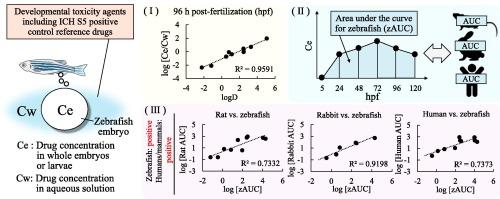Toxicokinetics of a developmental toxicity test in zebrafish embryos and larvae: Relationship with drug exposure in humans and other mammals
Abstract
To study the effects of drugs on embryo/fetal development (EFD), developmental and reproductive toxicity studies in zebrafish (Danio rerio) embryos is expected to be an accepted alternative method to animal studies using mammals. However, there is a lack of clarity in the relationship between the concentration of developmental toxicity agents in whole embryos or larvae (Ce) and that in aqueous solution (Cw), and also between the amount of drug exposure required to cause developmental toxicity in zebrafish embryos or larvae and that required in mammals. Here, we measured Ce for developmental toxicity agents every 24 h starting at 24 h post fertilization (hpf). We found a high correlation (R2: 0.87–0.96) between log [Ce/Cw] and the n-octanol–water distribution coefficient at pH 7 (logD) of each drug at all time points up to 120 hpf. We used this relationship to estimate the Ce values of the 21 positive-control reference drugs listed in ICH guidelines on reproductive and developmental toxicity studies (ICH S5). We then calculated the area under the Ce–time curve in zebrafish (zAUC) for each drug from the regression equation between log [Ce/Cw] and logD and compared it with the AUC at the no-observed-adverse-effect level in rats and rabbits and at the effective dose in humans described in ICH S5. The log of the calculated zAUC for the 14 drugs identified as positive in the zebrafish developmental toxicity test was relatively highly positively correlated with the log [AUC] for rats, rabbits, and humans. These findings provide important and positive information on the applicability of the zebrafish embryo developmental toxicity test as an alternative method of EFD testing. (267 words)


 求助内容:
求助内容: 应助结果提醒方式:
应助结果提醒方式:


